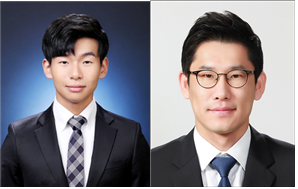loaction
공대뉴스광장
Research Team Led y SNU Professor Jung Won Park and Chung-Ang University Professor Jaeyoung Sung Discover Irregular Thermal Motion and Agglomeration of Ultra-Fine Nanoparticles of Less Than a Few Nanometers For the First Time. Solved Challenges of Motion
-
작성자
관리자
-
등록일
2021.12.16
-
조회수
913
Research Team Led y SNU Professor Jung Won Park and Chung-Ang University Professor Jaeyoung Sung Discover Irregular Thermal Motion and Agglomeration of Ultra-Fine Nanoparticles of Less Than a Few Nanometers For the First Time.
Solved Challenges of Motion and Reaction of Particles In Liquids That Are Part of the World of Ultra-Fine Scale That Cannot Be Explained By Existing Theories
Solved Challenges of Motion and Reaction of Particles In Liquids That Are Part of the World of Ultra-Fine Scale That Cannot Be Explained By Existing Theories

▲ From left, Ph.D candidate Sungu Kang of the Department of Chemical and Biological Engineering – the first author of the research paper, Professor Jung Won Park of the Department of Electrical and Computer Engineering – Corresponding author

▲ Figure summarizing research results published in Science Advances. The graphene-based liquid-phase transmission electron microscope device used by this research team and the image of the observed nanoparticles.
□ A joint research team led by Professor Jung Won Park of Seoul National University's Department of Electrical and Computer Engineering and Professor Jaeyoung Sung of the Department of Chemistry at Chung-Ang University identified for the first time in the world the irregular thermal motion of ultrafine nanoparticles with a size of less than several nanometers in the liquid and the aggregation between nanoparticles that occur through more than a single process through real-time liquid-phase transmission electron microscopy.
□ The uniform motion and agglomeration reaction of particles having a size at the micrometer level or larger can be well explained by Einstein's Brownian Motion Theory and classical chemical reaction kinetics, but whether it can explain the motion and aggregation behavior of ultra-fine nanoparticles in a liquid with a size of a few nanometers or smaller has remained unknown until now. It is difficult to observe ultrafine nanoparticles reaching a size of several nanometers with an optical microscope, and although it was possible to observe ultrafine nanoparticles with a conventional electron microscope, the observation of the dynamic phenomena of ultrafine nanoparticles in a liquid environment remained to be a difficult problem.
□ The joint research team succeeded in observing the motion and aggregation reaction of so many ultrafine nanoparticles that they were able to be statistically analyzed using a real-time transmission electron microscope using a graphene liquid container and a new model and theory were presented to quantitatively explain these experimental results, which cannot be explained by existing theories. In particular, a method has been prepared that can accurately extract and analyze even the behavior of nanoparticles that occur below the spatial resolution of an electron microscope. It was also found that the agglomeration reaction between nanoparticles occurs in two stages due to ligand molecules surrounding the nanoparticles, and it could be verified through the newly developed nanoparticle reaction kinetics that could explain the experimental results well.
□ The new research methodology presented in this study is expected to be widely used to observe and understand the liquid phase motion and chemical reaction dynamics of ultrafine nanoparticle systems, which is difficult to study with optical microscopy, using ultra-high resolution microscopy techniques including liquid phase transmission electron microscopy. In addition, it is expected that the nano-confinement environment will trigger studies on the changes in physical and chemical properties that the aqueous solution system causes.
□ The results of this research, which was conducted with the support from leader researchers, mid-sized researchers, and original technology development projects promoted by the Ministry of Science and ICT (or the Ministry of Education) and the National Research Foundation of Korea, was published on 'Science Advances', an international journal in the field of convergence science, on December 3, 2021.
담당부서대외협력실
전화번호880-9148